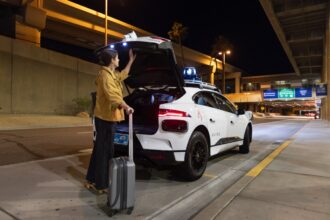Rimac, the Croatian EV upstart that ascended from a garage to become a supercar and technology powerhouse merged with Bugatti, has upgraded its Nevera hypercar. And along the way, Rimac managed to squeeze more power into it.
Rimac revealed Friday during The Quail, A Motorsports Gathering at Monterey Car Week the Nevera R, an all-electric hypercar that’s meant to push the performance bounds of its predecessor. The upshot: a hyper sports car that produces 2,107 horsepower, can reach a top speed of 217 miles per hour — or even 256 mph under Rimac’s oversight — and travel from zero to 60 mph in 1.74 seconds. The company hasn’t released an estimated range for the vehicle.
Those specs appear to support Rimac’s goal for the R in the new Nevera R’s name, which stands for radical, rebellious and relentless. The Nevera R’s larger wheels in the rear, extremely low nose, high rear-fixed-wing and carbon fiber structure completes the “hey-if-it-wasn’t-clear-this-is-a-gnarly-performance-hypercar” package.
The Rimac Nevera R, which debuted in Nebula green, puts the spotlight back on Rimac — and the ever-evolving and growing company.

The new EV is designed to do more than punch it off the line, however. Rimac Automobili founder Mate Rimac explained in a call prior to the reveal that the Nevera R, which is equipped with four electric motors, advanced ceramic brakes, a new 108 kilowatt-hour battery pack, new Michelin Pilot Cup tires and all-wheel torque vectoring, is designed for cornering.
“Nobody missed power in the Nevera,” CEO Mate Rimac said. “But we decided to, you know, squeeze a little bit more out that we knew we could still get out of the car. And, of course, give it a more aggressive, even more interesting design than before.”
Rimac will only produce 40 Nevera R units, which has a base price of 2.3 million euros ($2.5 million in today’s exchange rate).
For comparison, the original two-seater Nevera produces 1,914-horsepower, can accelerate from zero to 60 mph in 1.85 seconds and has a top speed of 258 mph. When Rimac Automobili began production of the original $2.5 million Nevera in 2022, those specs made it faster than any other production car.

Rimac Automobili brand was founded in 2009 by Mate Rimac, then a 21-year-old student. By 2011, he launched its first all-electric hypercar, the Concept One. The Concept Two would follow and eventually morph into the Nevera.
By the time the Rimac Nevera was revealed in 2021, Rimac was a unicorn startup that had also launched a technology subsidiary to supply other automakers such as backers Hyundai and Porsche with advanced EV components. That same year, Rimac would announce a merger with Bugatti, the iconic French supercar maker.
The company has a far more complex structure than its early days in Mate Rimac’s hobby garage. Bugatti-Rimac, which makes combustion, electric and hybrid hypercars, is majority owned by the Rimac Group and 45% owned by Porsche. Under Bugatti-Rimac is Rimac Automobili, which is the EV hypercar brand. The Rimac Group, of which Mate Rimac still holds a majority stake, also includes the Rimac Technology subsidiary and Verne, a newly launched robotaxi business.

“As you can see it’s quite a wide spectrum,” Mate Rimac said when explaining the company’s structure. “So the days are not very boring here. There is so much stuff happening.”
The Nevera R’s reveal also comes amid a topsy-turvy EV market. While EV sales continue to grow globally, U.S. and European automakers have struggled to deliver an affordable electric vehicle to customers, who have eschewed the costlier luxury models. A bevy of EV startups that charged into the industry several years ago in a bid to match Tesla’s success has dwindled to just a few.
Rimac, which has a different mission than those seeking to sell volumes of cheap EVs, has been one of the few success stories. “Just taking a normal car, making it electric, that’s not enough,” Mate Rimac said. “It has to be better; it has to offer something unique. And in our case, you know, the customer group that we are talking to, basically is collectors.”
Source : Techcrunch



